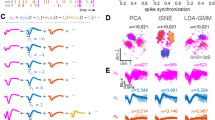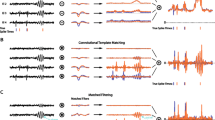Abstract
A new spike sorting method based on the support vector machine (SVM) is proposed to resolve the superposition problem. The spike superposition is generally resolved by the template matching. Previous template matching methods separate the spikes through linear classifiers. The classification performance is severely influenced by the background noise included in spike trains. The nonlinear classifiers with high generation ability are required to deal with the task. A multi-class SVM classifier is therefore applied to separate the spikes, which contains several binary SVM classifiers. Every binary SVM classifier corresponding to one spike class is used to identify the single and superposition spikes. The superposition spikes are decomposed through template extraction. The experimental results on the simulated and real data demonstrate the utility of the proposed method.







Similar content being viewed by others
References
Argoud FI, De Azevedo FM, Neto JM, Grillo E (2006) SADE3: an effective system for automated detection of epileptiform events in long-term EEG based on context information. Med Biol Eng Comput 44(6):459–470
Bankman IN, Johnson KO, Schneider W (1993) Optimal detection, classification, and superposition resolution in neural waveform recordings. IEEE Trans Biomed Eng 40(8):836–841
Boostani R, Graimann B, Moradi MH, Pfurtscheller G (2007) A comparison approach toward finding the best feature and classifier in cue-based BCI. Med Biol Eng Comput 45:403–412
Chandra R, Optican LM (1997) Detection, classification, and superposition resolution of action potentials in multiunit single-channel recordings by an on-line real-time neural network. IEEE Trans Biomed Eng 44:403–412
Chen AH, Zhou Y, Gong HQ, Liang PJ (2003) Chicken retinal ganglion cells response characteristics: multi-channel electrode recording study. Sci China Ser C 33:82–88
Cristianini N, Shawe-Taylor J (2000) An introduction to support vector machines. Cambridge University Press, Cambridge
Fee MS, Mitra PP, Kleinfeld D (1996) Variability of extracellular spike waveforms of cortical neurons. J Neurophysiol 76:3823–3833
Harris KD, Henze DA, Csicsvari J, Hirase H (2000) Accuracy of tetrode spike separation as determined by simultaneous intracellular and extracellular measurements. J Neurophysiol 84:401–414
Hsu CW, Lin CJ (2002) A comparison on methods for multi-class support vector machines. IEEE Trans Neural Netw 13:415–425
Kim KH, Kim SJ (2000) Neural spike sorting under nearly 0-dB signal-to-noise ratio using nonlinear energy operator and artificial neural-network classifier. IEEE Trans Biomed Eng 47:1406–1411
Kim KH, Kim SS, Kim SJ (2006) Improvement of spike train decoder under spike detection and classification errors using support vector machine. Med Biol Eng Comput 44:124–130
Lewicki MS (1994) Bayesian modeling and classification of neural signals. Neural Comput 6:1005–1030
Lewicki MS (1998) A review of methods for spike sorting: the detection and classification of neural action potentials. Netw Comput Neural Syst 9:53–78
Schmidt EM (1984) Computer separation of multi-unit neuroelectric data: a review. J Neurosci Methods 12:95–111
Shoham S, Fellows MR, Normamn R (2003) A robust, automatic spike sorting using mixtures of multivariate t-distributions. J Neurosci Methods 127:111–122
Sun S, Zhang C (2006) Adaptive feature extraction for EEG signal classification. Med Biol Eng Comput 44: 931–935
Takahashi S, Anzai Y, Sakurai Y (2003) Automatic sorting for multi-neuronal activity recorded with tetrodes in the presence of overlapping spikes. J Neurophysiol 89:2245–2258
Takahashi S, Sakurai Y (2005) Real-time and automatic sorting of multi-neuronal activity for sub-millisecond interactions in vivo. Neuroscience 134:301–315
Takahashi S, Sakurai Y, Tsukada M, Anzai Y (2002) Classification of neuronal activities from tetrode recordings using independent component analysis. Neurocomputing 49:289–298
Vogelstein RJ, Murari K, Thakur PH, Cauwenberghs G, Chakrabartty S, Diehl C (2004) Spike sorting with support vector machines. In: Proceedings of 26th annual international conference on IEEE engineering in medicine and biology society
Wang GL, Zhou Y, Chen AH, Zhang PM, Liang PJ (2006) A robust method for spike sorting with automatic overlap decomposition. IEEE Trans Biomed Eng 53:1195–1198
Zhang PM, Wu JY, Zhou Y, Liang PJ, Yuan JQ (2004) Spike sorting based on automatic template reconstruction with a partial solution to the overlapping problem. J Neurosci Methods 135:55–65
Zouridaks G, Tam DC (2000) Identification of reliable spike templates in multi-unit extracellular recording using fuzzy clustering. Comput Methods Programs Biomed 61:91–98
Acknowledgments
This study is supported by the National Natural Science Foundation of China (Grant No. 60574038) and the Specialized Research Fund for the Doctoral Program of Higher Education China (Grant No.20060248015).
Author information
Authors and Affiliations
Corresponding author
Rights and permissions
About this article
Cite this article
Ding, W., Yuan, J. Spike sorting based on multi-class support vector machine with superposition resolution. Med Bio Eng Comput 46, 139–145 (2008). https://doi.org/10.1007/s11517-007-0248-0
Received:
Accepted:
Published:
Issue Date:
DOI: https://doi.org/10.1007/s11517-007-0248-0




